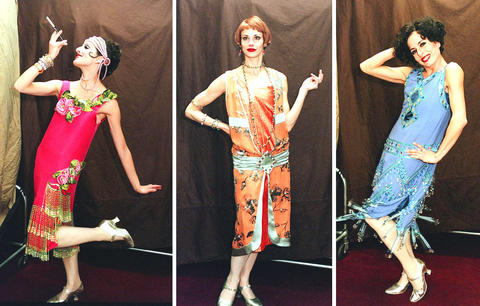From hair cropped short to smoking cigarettes and making-up in public, the Roaring Twenties revolutionized women's wear and lifestyles like no other era before, according to a new show in Paris.
It was the decade that saw the rise of the fashion magazine, the mass production of shoes and cosmetics, the baring of the body and the birth of rayon stockings - at first so shiny that women had to powder their legs.
As suffragettes cried out for the right to vote, a new androgynous silhouette surfaced on the fashion scene, turned out in mannish suits by day or flat-chested shifts by night, to dance the Charleston or listen to jazz.

PHOTO: NY TIMES NEWS SERVICE
"The spirit of the times was the emancipation of women and the female body," Sophie Grossiord, chief curator at Paris' Galliera fashion museum, said, ahead of Saturday's opening of The Roaring Twenties.
"They were exciting dynamic times," she said. "They set the stage for [women's] wear today."
As Picasso, Leger or Max Jacob took in the new Afro-jazz beat in their favorite Paris haunt and Gertrude Stein hung out with literary giants Ernest Hemingway or Ezra Pound, equally momentous creative change was afoot in the world of women's wear.
The exhibition, which runs until Feb. 29, features 170 models and scores of accessories dished up by ground-breaking, legacy-leaving designers of the time - Paul Poiret, Jean Patou, Jeanne Lanvin, Perugia, Suzanne Talbot and Madeleine Vionnet.
With women in the post-war era shoving aside restrictive corsets and precision-molded couture in the hopes of winning body freedom, the designers knocked out waists, brought up hemlines and all but suppressed the bust.
The result, in the cabaret heyday of Josephine Baker and Maurice Chevalier, was the loose drop-waisted shift worn to dance the charleston, the fox-trot or the blackbottom.
With the new straight flapper-style haircuts, came short sleek hair - a revolution after centuries during which a women's hair was supposed to be her crowning glory - often crammed under a "cloche" hat pulled down over the eyes, meaning women had to hold their heads up to see where they were going.
As hems went up, shoes became important. And as cosmetics took off, Chanel launched its No 5 in 1921, while in 1925 Guerlain produced Shalimar and Lanvin created My Sin.
The flappers smoked cigarettes, adopted pyjamas for lounging around at home, wore make-up, formerly associated with prostitutes, and at their most mannish and sexually unclear, wore ties, suits, bowler hats and sported monocles.
The decade also marked the triumph of iconic 1920s designer Coco Chanel, whose easy-to-wear fluid jersey outfits in simple shapes and neutral tones were made for the comfort and ease of the new 20th century woman.
"The jersey outfits became a basic for women though jerseys until the previous decade had been used for sportswear," said Grossiord. "Women would wear these until four or five in the afternoon when they'd change for the evening."
Like today's big-name designers, the exhibition also highlights the influences of the age on fashion - Art Deco prints and Egyptian and Asian touches following the discovery of Tutankhamen's tomb in 1922 or an exhibit on Angkor Wat.
A Poiret jacket was even made out of a Russian embroidered table-cloth picked up by the couturier during a journey.
To top off the show, the Roaring Twenties are also to be the theme of a series of other cultural events in Paris this autumn and winter, including film, song and a display of crystal from the times at the Baccarat museum.

Oct. 27 to Nov. 2 Over a breakfast of soymilk and fried dough costing less than NT$400, seven officials and engineers agreed on a NT$400 million plan — unaware that it would mark the beginning of Taiwan’s semiconductor empire. It was a cold February morning in 1974. Gathered at the unassuming shop were Economics minister Sun Yun-hsuan (孫運璿), director-general of Transportation and Communications Kao Yu-shu (高玉樹), Industrial Technology Research Institute (ITRI) president Wang Chao-chen (王兆振), Telecommunications Laboratories director Kang Pao-huang (康寶煌), Executive Yuan secretary-general Fei Hua (費驊), director-general of Telecommunications Fang Hsien-chi (方賢齊) and Radio Corporation of America (RCA) Laboratories director Pan
The consensus on the Chinese Nationalist Party (KMT) chair race is that Cheng Li-wun (鄭麗文) ran a populist, ideological back-to-basics campaign and soundly defeated former Taipei mayor Hau Lung-bin (郝龍斌), the candidate backed by the big institutional players. Cheng tapped into a wave of popular enthusiasm within the KMT, while the institutional players’ get-out-the-vote abilities fell flat, suggesting their power has weakened significantly. Yet, a closer look at the race paints a more complicated picture, raising questions about some analysts’ conclusions, including my own. TURNOUT Here is a surprising statistic: Turnout was 130,678, or 39.46 percent of the 331,145 eligible party

The classic warmth of a good old-fashioned izakaya beckons you in, all cozy nooks and dark wood finishes, as tables order a third round and waiters sling tapas-sized bites and assorted — sometimes unidentifiable — skewered meats. But there’s a romantic hush about this Ximending (西門町) hotspot, with cocktails savored, plating elegant and never rushed and daters and diners lit by candlelight and chandelier. Each chair is mismatched and the assorted tables appear to be the fanciest picks from a nearby flea market. A naked sewing mannequin stands in a dimly lit corner, adorned with antique mirrors and draped foliage

President William Lai (賴清德) has championed Taiwan as an “AI Island” — an artificial intelligence (AI) hub powering the global tech economy. But without major shifts in talent, funding and strategic direction, this vision risks becoming a static fortress: indispensable, yet immobile and vulnerable. It’s time to reframe Taiwan’s ambition. Time to move from a resource-rich AI island to an AI Armada. Why change metaphors? Because choosing the right metaphor shapes both understanding and strategy. The “AI Island” frames our national ambition as a static fortress that, while valuable, is still vulnerable and reactive. Shifting our metaphor to an “AI Armada”